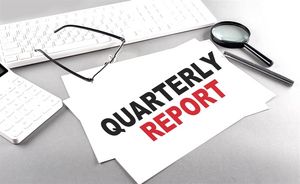
The U.S. stock market is experiencing a period of cautious trading, with major indexes pulling back slightly from their recent highs as investors brace for crucial inflation data set to be released this week. This subdued sentiment reflects a broader anxiety on Wall Street regarding the trajectory of inflation and its potential implications for monetary policy and corporate earnings. The slight retrenchment in the S&P 500, Dow Jones Industrial Average, and Nasdaq Composite underscores a market holding its breath, keenly aware that the upcoming reports could dictate the market's direction for the foreseeable future.
This current market pause comes after a period of robust gains, with all three major indexes having posted significant year-to-date performance. However, the specter of persistent inflation has introduced a degree of uncertainty, prompting investors to adopt a more defensive posture. The anticipation of the Consumer Price Index (CPI) and Producer Price Index (PPI) reports is particularly acute, as these figures will offer critical insights into the effectiveness of the Federal Reserve's (Fed) efforts to tame rising prices and could influence future interest rate decisions.
Market Pullback and the Inflationary Crossroads
The past few trading sessions have seen a modest but noticeable retreat across the board. The S&P 500 (SPX) has edged down from its recent peaks, as has the Dow Jones Industrial Average (DJIA), which represents a basket of 30 large, publicly traded U.S. companies. The technology-heavy Nasdaq Composite (IXIC), often more sensitive to interest rate expectations due to its growth-oriented constituents, has also experienced a slight deceleration in its upward momentum. This pullback is not indicative of a major market correction but rather a strategic de-risking by investors ahead of potentially market-moving news.
This cautious environment is a direct consequence of the market's laser focus on inflation. For months, the Federal Reserve has been navigating a delicate balance, aiming to bring inflation down to its 2% target without triggering a significant economic downturn. The timeline leading up to this moment has been characterized by a series of interest rate hikes, quantitative tightening, and forward guidance from Fed officials, all designed to cool the economy and curb price pressures. However, recent economic indicators, while showing some signs of moderation, have not definitively signaled a clear path back to the Fed's target, leaving investors on edge.
Key players in this unfolding narrative include the Federal Reserve, whose policy decisions are paramount; institutional investors and hedge funds, who are adjusting their portfolios in anticipation of the data; and individual retail investors, who are closely watching for signs of market direction. Initial market reactions have been characterized by lower trading volumes and a preference for less volatile assets, reflecting a "wait-and-see" approach. The upcoming CPI report, in particular, is viewed as a pivotal moment, with any significant deviation from expectations likely to trigger a more pronounced market response.
Navigating the Inflationary Tides: Potential Winners and Losers
The impending inflation data has the potential to create distinct winners and losers across various sectors and companies, depending on the figures released and the subsequent market interpretation. Companies with strong pricing power and those in defensive sectors are generally better positioned to weather an inflationary environment, while highly leveraged firms and growth stocks may face headwinds.
Should inflation prove stickier than anticipated, companies in the financial sector, such as JPMorgan Chase & Co. (NYSE: JPM) and Bank of America Corporation (NYSE: BAC), could potentially benefit from higher interest rates, which typically improve net interest margins. Similarly, energy companies like Exxon Mobil Corporation (NYSE: XOM) and Chevron Corporation (NYSE: CVX) often perform well during inflationary periods due to rising commodity prices. Consumer staples giants like Procter & Gamble Co. (NYSE: PG) and Coca-Cola Co. (NYSE: KO) might also demonstrate resilience, as their products are essential and less susceptible to discretionary spending cuts, allowing them to pass on increased costs to consumers.
Conversely, a persistently high inflation reading could put pressure on growth-oriented technology companies, many of which are listed on the Nasdaq. Companies like Tesla, Inc. (NASDAQ: TSLA) and NVIDIA Corporation (NASDAQ: NVDA), whose valuations often rely on future earnings potential, can see their discounted future cash flows diminish in a higher interest rate environment. Highly leveraged companies across various sectors could also face increased borrowing costs, impacting their profitability and expansion plans. Furthermore, sectors heavily reliant on consumer discretionary spending, such as retail and hospitality, might experience a slowdown if inflation erodes consumer purchasing power.
Industry Impact and Broader Implications
The current market dynamics, driven by inflation concerns, fit squarely into broader industry trends characterized by supply chain recalibrations, evolving consumer behavior, and a global push towards economic normalization post-pandemic. Persistent inflation could exacerbate existing supply chain issues, as rising input costs for raw materials and labor ripple through manufacturing and distribution networks. This could lead to higher prices for consumers and reduced profit margins for businesses unable to fully pass on these costs.
The potential ripple effects extend to competitors and partners across various industries. For instance, if a key supplier faces increased costs dueits own inflationary pressures, it could impact the production capabilities and profitability of its downstream partners. Regulatory and policy implications are also significant; a hotter-than-expected inflation report could compel the Federal Reserve to maintain a more hawkish stance, potentially leading to further interest rate hikes or a longer period of restrictive monetary policy. This, in turn, could tighten credit conditions, impacting everything from corporate borrowing to mortgage rates.
Historically, periods of high inflation have often been associated with market volatility and economic uncertainty. Comparisons can be drawn to the late 1970s and early 1980s, when the Fed aggressively raised interest rates to combat runaway inflation, leading to a recession but ultimately stabilizing prices. While the current economic landscape differs significantly, the underlying principle remains: controlling inflation is paramount for long-term economic stability, and the market's reaction to the Fed's efforts is a critical barometer of investor confidence.
What Comes Next
The immediate future of the market hinges significantly on the upcoming inflation reports. A lower-than-expected CPI or PPI reading could provide a much-needed boost to investor confidence, potentially signaling that the Fed's policies are working and that a "soft landing" for the economy is achievable. This scenario could lead to a rebound in growth stocks and a broader market rally, as the prospect of a less aggressive Fed becomes more tangible.
Conversely, if inflation proves to be more stubborn than anticipated, the market could face renewed selling pressure. This might prompt the Federal Reserve to consider further interest rate hikes or maintain higher rates for an extended period, increasing the risk of a recession. In such a scenario, investors might continue to favor defensive sectors and value stocks, while highly leveraged companies and those sensitive to interest rates could face ongoing challenges. Companies may need to implement strategic pivots, focusing on cost efficiencies, supply chain resilience, and pricing strategies to maintain profitability.
In the short term, market opportunities may emerge for nimble investors who can identify undervalued assets or sectors poised to benefit from specific inflation outcomes. Long-term, the focus will remain on corporate earnings, economic growth, and the Fed's ability to navigate the inflationary landscape without stifling economic activity. Potential scenarios range from a gradual disinflationary trend leading to a sustained bull market to a more prolonged period of economic stagnation if inflation remains elevated and growth falters.
Conclusion
The current market pullback, while modest, serves as a stark reminder of the pervasive influence of inflation on financial markets. The anticipation of key inflation data has created a palpable sense of caution among investors, highlighting the critical role these economic indicators play in shaping sentiment and guiding investment decisions. The slight retrenchment in the S&P 500, Dow Jones Industrial Average, and Nasdaq Composite underscores a market that is highly sensitive to the nuances of economic data and the Federal Reserve's policy responses.
Moving forward, the market's trajectory will largely depend on whether inflation shows clear signs of moderating towards the Fed's target. Investors should closely monitor not only the headline inflation figures but also underlying components, such as core inflation (excluding volatile food and energy prices), and wage growth, which can provide insights into persistent price pressures. The coming months will be crucial in determining whether the U.S. economy can achieve a soft landing or if further economic adjustments will be necessary to bring inflation under control.
Ultimately, the current environment emphasizes the importance of a well-diversified portfolio and a long-term investment horizon. While short-term volatility is likely to persist as the market digests new economic data, the fundamental strength of corporate earnings and the broader economic outlook will remain key drivers. Investors should watch for clear signals from the Federal Reserve regarding its future policy path and continue to assess how individual companies are adapting to the evolving inflationary landscape.





